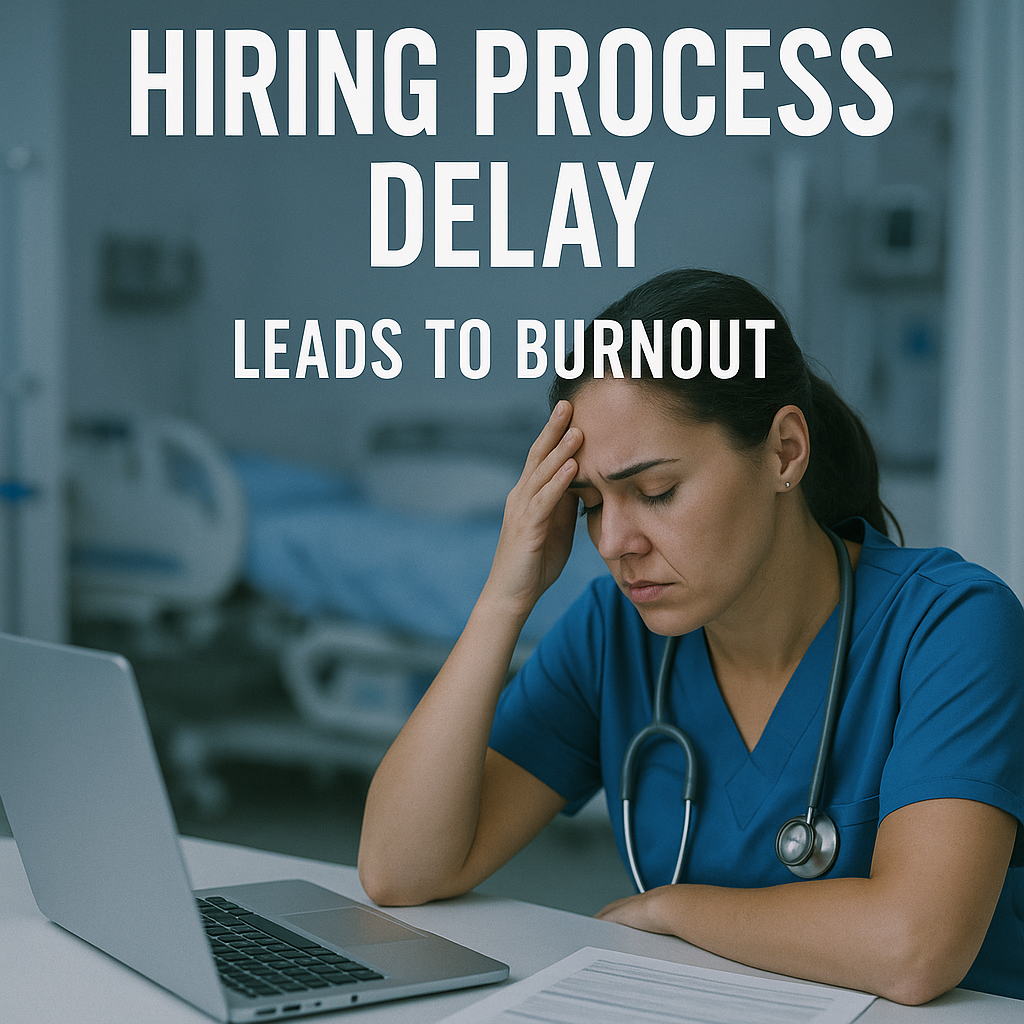Key Takeaways
- Healthcare hiring is not accidentally slow. It is the result of legacy workflows, risk mitigation, and bureaucratic controls designed for a different era.
- Slow hiring creates an internal fallout, including burnout, overtime spikes, and cascading backfill gaps that destabilize entire care units.
- Candidates drop off or disengage when delays stack up, reducing your ability to secure high-fit talent and increasing reliance on temporary staffing.
- Until leadership redesigns the system itself, hiring will remain a drag on care delivery, regardless of recruiter effort or technology investment.
By Tiny Manyonga
If your ER ran like the healthcare hiring process, it would be a scandal. In healthcare, the cost of medical staffing delays is severely consequential, and recruitment is no exception. In our last article, we unpacked the direct financial toll of reactive hiring: overtime premiums, agency fees, safety incidents, and lost revenue from unstaffed beds. But here is the harder truth: most hiring delays are not just unfortunate. They are engineered into the system.
Before we go further, it is worth stating plainly: the nursing shortage is real. The U.S. Bureau of Labor Statistics projects that more than 275,000 additional nurses will be needed from 2020 to 2030 to meet rising demand. At the same time, nearly one in five healthcare workers have left the profession since 2020, with the largest attrition among frontline roles. This challenge is compounded by the aging population. By 2030, all baby boomers will be over 65, significantly increasing the need for clinical care, especially in long-term and chronic care settings.
In this context, every vacancy hurts more, lasts longer, and costs more to fill. Despite the overall shortage, qualified clinicians are still actively applying for roles that match their preferred locations and practice settings. However, the problem is not just scarcity, it is poor matchmaking. The market remains ill-equipped to fit square pegs in square holes, often relying on outdated tools that overlook nuance, compatibility, and timing. Delayed hiring does not just mean fewer hands on deck, it creates cascading pressure on the entire system.
Unlike clinical operations, where time is measured in minutes and outcomes, hiring is trapped in legacy workflows. These include slow requisition approvals, fragmented communication, and hiring steps that still resemble a 1990s HR manual. As a result, critical roles stay open while frontline staff scramble, candidates walk, and leadership absorbs the cost.

This is not just a process problem, it is a structural design flaw. One that was never built for speed, never rebuilt for today, and now risks turning hiring into a full-blown operating liability.
Medical Staffing Delays Are Not a Bug – They are the System
Delays in healthcare hiring do not happen because decision-makers are indifferent. In fact, most are actively working to improve their performance. Regardless, the lumbering machinery persists because the system is, incidentally, designed for slowness. Approval chains stretch across HR, finance, and department heads. Credentialing, while critical for patient safety, is rarely parallelized. Furthermore, most organizations have no real-time visibility into pipeline health.
Ironically, the sluggish recruitment system may be a lingering consequence of a historical abundance of unemployed or underemployed nurses. Following the Great Recession, hospitals implemented additional layers of credential scrutiny and HR protocols, and raised the minimum requirements for healthcare professionals (Stateline, 2016). In a market with a surplus of nurses, why hire one with an Associate’s degree when you can get one with a Bachelor’s?
These redundant verifications, motivated by fear of liability or being outperformed by competitors, remained even as the supply of nurses dwindled. Simultaneously, HR tech investment lagged clinical tech upgrades. While hospitals adopted advanced EMRs and surgical robotics, hiring often remained reliant on a lengthy, opaque recruitment process, untracked referrals, and fragmented scheduling.
We are now living with that drag. Facilities trying to modernize recruitment are still constrained by decade-old assumptions about risk, speed, and control. This system does not need tweaks; it needs a redesign. It was built to slow things down, and it still works exactly as intended. That is the problem. Even when there is urgency, there is rarely a process that reflects it. Unlike ERs or ICUs where protocols kick in under pressure, hiring delays are treated as bureaucratic noise not operational risk. The penalties for this unintended negligence are not insignificant.
The Internal Fallout: Burnout, Attrition, and Eroded Trust
Like any neglected system, that slowness has consequences that start with your own medical staff.
When hiring stalls, the workload does not. Teams stretch to cover the gaps. Healthcare workers report covering longer and extra shifts due to prolonged vacancies, with over half citing exhaustion and burnout as a top concern and a leading reason why nurses quit. Additional data from the 2025 NSI National Health Care Retention & RN Staffing Report highlights a 18.3% average turnover rate among hospital staff nurses, often linked to overwork and unsustainable schedules. The longer this cycle runs, the deeper the burnout, especially when the expectation to overextend becomes normalized.
Hiring friction also erodes the psychological contract between staff and leadership. Workers expect support, not silence. In environments where roles remain unfilled for weeks or months, employees begin to internalize the delay as disregard. According to the Relias 2022 Nurse Salary Report, 43% of nurses cited lack of organizational support as a reason for leaving their role, a figure that underscores how perceptions of inaction drive actual attrition. Morale drops, peer trust fractures, and retention suffers.
All of this weakens team cohesion and increases downstream churn. The cost of an empty seat is high, but the cost of a demoralized workforce is steeper and longer lasting.

The External Fallout: Dropped Candidates, Reputation Loss
Internal exhaustion is only half the fallout. On the outside, lagging systems send a louder message.
The window to engage top healthcare talent is short; and it is getting shorter. In a study by Apploi, 71% of nurses who walked away from offers cited slow or no follow-up as the reason. Similarly, a 2023 survey by HireVue found that 54% of healthcare candidates abandoned the hiring process due to long waiting times or poor communication. Candidates often interpret delay as disinterest or disorganization, especially when more responsive employers are in their inbox the same day.
Every candidate dropped is a pipeline weakened. More than that, it is a reputational hit. According to the 2023 Healthcare Recruiting Survey by Vivian Health, 52% of clinical candidates said they would not reapply to a facility that failed to communicate clearly or timely during the healthcare hiring process. Meanwhile, research from the Talent Board found that 63% of candidates who had a negative experience shared it with others, mostly in professional circles. Candidates do not just disappear, they debrief. The feedback they share travels fast, especially in tightly networked clinical communities.
Worse, slow hiring does not just signal inefficiency. It signals indecision. And in a labor market this thin, that is enough to push your facility off a candidate’s list permanently.
From Applications to Beyond Onboarding: Re-engineering Medical Staffing
When delays hit, most providers believe the default fix is volume. Post more jobs, widen the net, and pay for more sourcing tools. However, the issue is not merely lack of applicants, it is a flawed funnel that was never engineered for urgency, trust, or clinical fit. A funnel that slows the very decisions it was meant to support. So, if slowness is systemic and the fallout is wide-ranging, what does it actually take to fix the funnel?
There are some solutions, such as job boards offer more access, but not traction. What most healthcare systems need is not more resumes. It is faster, smarter, trust-based decision-making across departments.
That shift does not start with sourcing. It starts with reengineering how recruitment functions end to end.
To fix this, recruitment must operate with the same urgency and coordination as care delivery:
- Hiring plans tied to census trends and seasonal patterns.
- Credentialing and vetting that runs in parallel, not in sequence.
- Hiring managers looped in early, not after HR has screened.
- Outreach that keeps candidates informed and engaged every step of the way.
Once we realized that this is not about speed for speed’s sake and that it is about designing systems where trust is built faster than it is burned, we set out to change the game.
At Nava Healthcare, we do not just find talent. We fix the bottlenecks that keep you from hiring them. That means building full-funnel infrastructure: sourcing, screening, behavioral alignment, credentialing, and onboarding – all with clinical insight at the core.
We do not hand off a stack of resumes. We maintain active relationships with pre-qualified professionals, so you are never starting from zero. Our recruiters understand unit dynamics, not just job descriptions. And we track every step of the pipeline, so you do not lose candidates to silence or delay.
Every facility builds protocols for infection control, disaster response, and critical care. Why not for recruitment?
Recruitment delays are not just a paperwork problem. They are an operational liability. And the sooner you treat them that way, the faster you regain control of your workforce.
You may now be realizing that this systemic issue is not just about filling roles but about reengineering the structure that supports healthcare hiring. Some leaders will look for a partner who can act as an architect, helping to design a system built for clinical efficiency.
Others, still, may believe that once equipped with the right insights, they can simply reinforce their recruitment tools; maybe add a referral bonus here, upgrade the ATS there, and tweak their social media for more views. In our next article, we will explore why that kind of remodeling often fails. Job boards and related tools were never built to handle clinical complexity, behavioral nuance, or long-term retention. They are tools, not strategy . We will then examine the gap between what these platforms offer and what real healthcare hiring requires, and map out what it takes to move from patchwork fixes to strategic redesign.
[TM2]Link to Article 3.